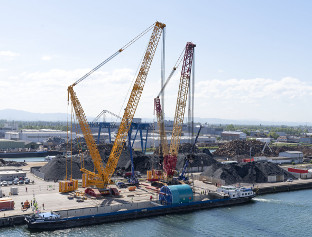Liebherr heavyweights work in tandem
1 October 2019Two Liebherr crawler cranes, an LR 11350 and an LR 11000, worked in tandem to load a tunnel boring machine onto a barge at the Rhine port of Kehl in Baden-Württemberg, Germany.
The tunnel boring machine, built by Herrenknecht based in Schwanau, Baden-Württemberg, weighed around 900t. This was the heaviest item that had to be handled at the 119-year old port.
The 1,350t LR 11350 and the 1,000t LR 11000, the second and third most powerful Liebherr crawler cranes, were chosen by the German subsidiary of Mammoet for the job. The LR 11350 was hired from crane rental company van Adrighem and the LR 11000 was hired from Wiesbauer, a crane service provider based in southern Germany.
The two heavyweights had arrived on barges using the inland waterways. Whilst the components of Wiesbauer’s crawler crane were put on board for the short trip from Mannheim, the LR 11350, still in the livery of its original owner, Scottish crane contractor Weldex, was loaded onto a barge in Rotterdam from where it was shipped to southern Germany.
When they arrived, however, it was not just the crawler cranes that had to be assembled and prepared. In addition, the various components of the nine-metre diameter tunnel drilling machine, which they had to load, had to be transported from the Herrenknecht factory in Schwanau, 30km away, and then assembled at Kehl. The heavyweight components included the core piece of a tunnel drilling machine, consisting of the front blade area with all its components and installations such as the cutting wheel, drive and erector, a device for installing the tunnel shuttering. The handling and transport work required the installation of a so-called blade cradle underneath the earth drill.
This blade cradle also contained the fastening points for the attachment equipment on the two crawler cranes. This is where the extremely heavy steel ropes, as thick as a man’s leg, were secured using massive shackles.
The experienced team from Mammoet required several hours to hoist the machine onto the barge, as placing a further 300t of steel onto the suspended ballast pallet of the LR 11350 during the slewing process proved to be an extremely time-consuming undertaking. A considerable number of counterweight blocks were required, since the load had to be lowered into the hold at a radius of around 30m – during the final phase of the hoist, the two cranes had a total of 1,600t of ballast.
This radius resulted from the large distance between the two cranes and to the barge and was based on the structural strength of the loading platform. As a result of the enormous ground pressure, the load capacity of the ground in this area had to be recalculated to find safe areas for the crawler cranes to be positioned. It was a masterful performance by the two heavyweights to achieve this significant radius with an imposing gross load totalling around 950t on the hook.
The subsequent journey on the barge to the Dutch coast then took five days. When it arrived at the port of Rotterdam, the large drilling machine was unloaded by a floating crane. In November it will then be shipped over the English Channel to build a tunnel in Great Britain.